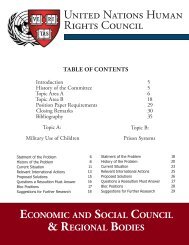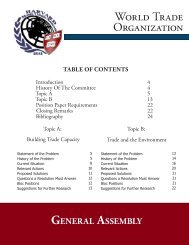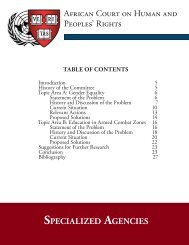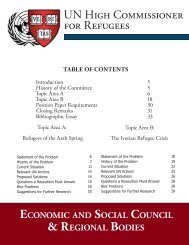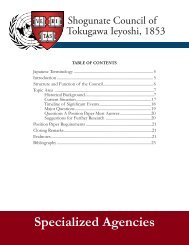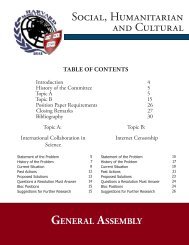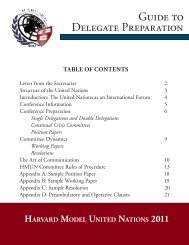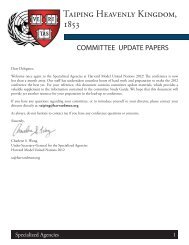Japanese Kantei 2016 - Harvard Model United Nations
Japanese Kantei 2016 - Harvard Model United Nations
Japanese Kantei 2016 - Harvard Model United Nations
Create successful ePaper yourself
Turn your PDF publications into a flip-book with our unique Google optimized e-Paper software.
<strong>Japanese</strong> <strong>Kantei</strong>: <strong>2016</strong><br />
Committee Update<br />
Th e Ya k u z a: Ba c k g r o u n d<br />
The long and varied relationship the Yakuza has held<br />
with Japan may seem very strange to foreigners. The<br />
term “organized crime” brings to mind images of mafia<br />
godfathers, family-style organizations, and an underworld<br />
network of influence by which the gangs intimidate their<br />
way into money and power; all of these images apply to<br />
the Yakuza, but these gangsters operate in a fashion quite<br />
distinct among organized criminals. Their distinctive<br />
culture, supposedly based in a rigid moral code and<br />
traditional family values, combined with an interest in<br />
influencing politics and racketeering, has made them an<br />
intrinsic part of Japan, for better or worse. In these past<br />
few decades, however, the sureness of their continuing<br />
influence has been deeply shaken.<br />
Although it may be a little fanciful, modern-day<br />
Yakuza insist that their roots reach as far back as the<br />
17 th century, when packs of newly unemployed samurai<br />
(called “ronin”) began harassing small towns. Groups of<br />
townsfolk, known as “machi-yokko” organized to resist<br />
the onslaught; according to legend these were Robin<br />
Hood-like figures who protected the helpless, strictly<br />
adhering to the dual principles of “giri” and “ninjo” (two<br />
<strong>Japanese</strong> concepts that have no true English translation;<br />
the closest approximation is a sense of obligation or<br />
being tied by fate, and compassion, respectively.) These<br />
machi-yokko, honorable outlaws, came to be a cultural<br />
phenomenon, starring in innumerable legends and tall<br />
tales. Over time, however, the need for such vigilantes<br />
passed and Japan was left with disorderly bands of young<br />
men with a penchant for violence and the habit of being<br />
able to do as they please. As the anxious government<br />
began to crack down on such groups, their membership<br />
shifted towards a rougher demographic, namely the<br />
“burakumin” (Japan’s caste of ancestral outcasts, similar<br />
to Indian untouchables; it is estimated that up to 60%<br />
of modern Yakuza have burakumin ancestry.) In fact, the<br />
term “Yakuza” is actually a reference to the worst possible<br />
hand in a popular <strong>Japanese</strong> card game, indicating the<br />
unlucky lot of these burakumin. These newer gangs,<br />
deprived of their original function, turned to two main<br />
illicit sources of income, depending on their location. In<br />
the towns and cities, the “tekiya” sprang up – an umbrella<br />
term for any of the various street vendors of shoddy or<br />
illegal goods. Along the main highways, gangs of machiyokko<br />
known as “bakuto” established a monopoly on<br />
gambling dens. Both groups, tekiya and bakuto, still<br />
mainly comprise the modern concept of the Yakuza.<br />
The ideal Yakuza gang is a microcosm of <strong>Japanese</strong><br />
culture and values: its organization, traditions, and even<br />
political affiliations all reflect the rich history of <strong>Japanese</strong><br />
society as a whole. Following the traditional <strong>Japanese</strong><br />
family dynamics, Yakuza gangs are organized around<br />
father-son, or oyabun-kobun, relationships, with one<br />
oyabun having many kobun, similar to the godfather and<br />
family typical of American mafia. This creates a pyramidal<br />
structure that may include sub-oyabun depending on the<br />
size of the gang, as well as “older brothers” and “younger<br />
brothers” among the kobun. Each oyabun-kobun tie<br />
entails a deep, lasting obligation, including willingness to<br />
sacrifice one’s life or go to prison for the good of the gang.<br />
Besides these ties, gangs also participate in rituals (often<br />
with Shinto elements) to mark members, from full-body<br />
tattooing and removal of the final joint of the little finger<br />
(this last ritual was based in the idea that the partially<br />
crippled hand would decrease one’s sword-wielding<br />
ability, forcing co-dependence among gang members.)<br />
Although it would be impossible to generalize the<br />
ideologies of all of the many Yakuza throughout history,<br />
typically Yakuza have maintained a strong nationalist<br />
affiliation, beginning with their traditional Shinto regard<br />
of the emperor as a divine being, a belief which over<br />
time progressed into an anti-communist and anti-liberal<br />
stance. As a result, conservative and even ultra-nationalist<br />
and fascist leaders of Japan have come to see the Yakuza<br />
as a powerful tool, a physical means for ends with which<br />
politicians wish not to be tied. This tie between the Yakuza<br />
and politics began as simple offers from Yakuza bosses<br />
to local politicians of discreet physical intimidation of<br />
opponents, protestors, etc. With time and increasing<br />
dependence on the success such intimidation brought,<br />
Yakuza intimidation grew to massive proportions, from<br />
violent strike-breaking and violent policing work to<br />
even assassinations. Secret liaisons between politicians<br />
and the Yakuza bosses, known as “kuromaku” (after the<br />
name of the curtain-operator in Kabuki plays,) wielded<br />
immense power and wealth, determining the outcome of<br />
elections, public policy, and even foreign relations using<br />
the politicians’ faces and coalitions of Yakuza strength.<br />
Even the U.S. officers in charge of the Occupation of<br />
Japan were not above soliciting Yakuza assistance for<br />
intelligence purposes, despite the gangs’ opposition to<br />
both foreigners and the democracy the Americans were<br />
2 Specialized Agencies





